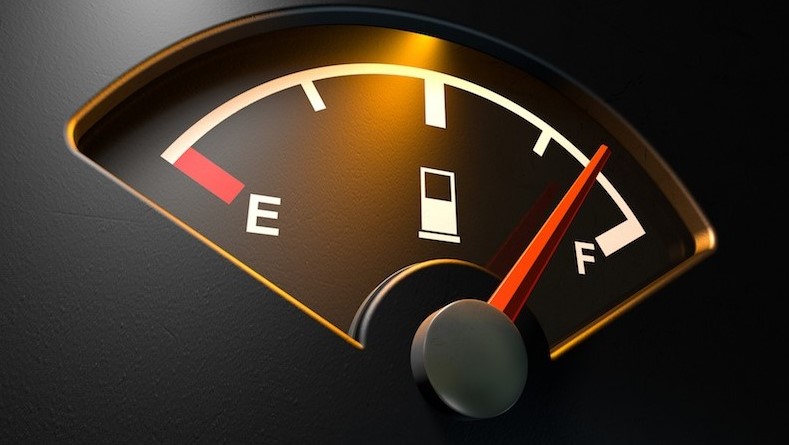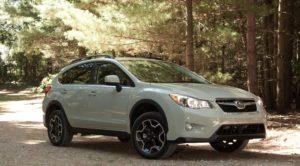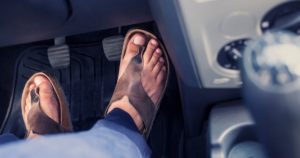Fuel efficiency is a primary issue when it comes to selecting the car you want to buy. Suppose you are looking to have affordable transportation costs. But did you know that you can make your vehicle more fuel-efficient by altering some of its features such as the tires?
While it is not common knowledge, you can make your car fuel efficient by using tires that do not make your car work extra hard on the road. This may entail some trial and error, but having a few fuel-efficient tire options certainly takes the guesswork out of the equation. Here are the best car tires for fuel-efficiency.
Top 5 Best Tires for Fuel Efficiency
GOODYEAR ASSURANCE FUEL MAX
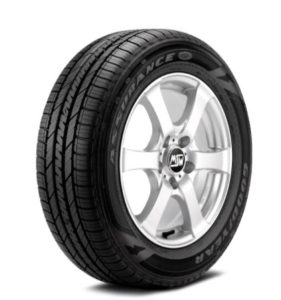
Goodyear tires are affordable, and they offer long wear, wet traction, and low rolling resistance. Whether you own a coupe, van, or crossover vehicle, these tires would be ideal for your car. They are designed to provide year-round confidence in wet, dry, and winter weather conditions, specifically light snow. They are guaranteed to enhance vehicle fuel economy over the tire’s lifetime.
The tire’s tread design features distinct zones for optimal performance. The Inboard and outboard Dry Tread Zones have strong shoulder blocks to enhance handling in dry conditions. The central Wet Tread Zone has Dual Aqua channel grooves that evacuate water to promote wet weather traction. Additionally, the continuous notched center rib combined with circumferential shoulder grooves offer dry road stability and even tread wear. As well as traction in snowy conditions.
The tire’s interior has twin steel belts – with the H-speed rated sizes reinforced with spirally wrapped nylon belt edge strips on top of a polyester casing to enhance ride quality.
Features
- Dual Aqua channel grooves
- Notched center rib
- Twin steel belts
- Polyester casing
- Six-year Tread life warranty
- 1-year uniformity warranty
Pros
- Long-wear
- Wet traction
- Low rolling resistance
Cons
- The treads wear out pretty fast
Check it here: https://www.tirerack.com/tires/tires.jsp?tireMake=Goodyear&tireModel=Assurance%20Fuel%20Max&partnum=255HR7AFMV3
CONTINENTAL CROSSCONTACT LX20 WITH ECOPLUS TECHNOLOGY
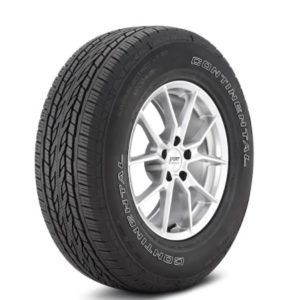
These Continental Ecoplus tires are designed to help crossovers, sport utility vehicles, and light-duty pickup trucks perform optimally on the highway and in mild off-road conditions. The tires enhance driving pleasure, save fuel, and maintain grip when braking on wet surfaces. They also provide long term and all-season traction, even in light snow.
The tires are made using an all-season tread compound made of custom Continental’s Tg-F Polymers and +Silane additives. The material used improves tread wear and traction on slippery roads. The tire features an asymmetric tread design with notched outboard shoulders, independent intermediate tread blocks, and continuous center ribs.
These features ensure that the tires have on-road steering response and straight-line stability. As well as reduced noise and enhanced ride comfort. Additionally, the tire’s grooves promote three-dimensional snow-to-snow traction. The twin steel belts forming the internal structure are reinforced with spirally wrapped polyamide on top of a polyester cord casing for increased durability and ride comfort.
Features
- Material: Tg-F Polymers and +Silane additives
- Notched outboard shoulders
- Intermediate tread blocks
- Continuous center ribs
- Continental’s Traction Grooves
- Three-dimensional snow-to-snow traction.
- Twin steel belts
- Flanged lower sidewall
- 1-year uniformity warranty
- 6-year workmanship warranty
- 6-year tread life warranty
Pros
- Durable
- All-season traction
- Straight-line stability
Cons
- Does not provide traction on icy roads
Check it here: https://www.tirerack.com/tires/tires.jsp?tireMake=Continental&tireModel=CrossContact%20LX20%20with%20EcoPlus%20Technology&partnum=375SR6CCLX20OWL
CONTINENTAL CONTI ECO CONTACT EP
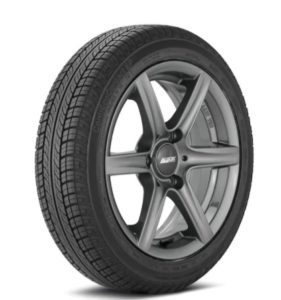
Continental tire’s low rolling resistance design helps to save fuel and reduce vehicle CO2 emissions; while providing traction in dry and wet road conditions. These tires are not intended to be driven in near-freezing temperatures, through snow or on ice.
The tires are made from a silica-enhanced compound for increased durability. They have an asymmetric design with solid tread blocks and a continuous rib on the outboard shoulder. This helps to promote responsiveness and cornering stability.
The tires also feature a continuous center rib that provides constant rubber-to-road contact. This reduces noise and controls the longitudinal forces experienced when braking. The circumferential tread grooves and independent tread blocks on the inboard tread resist hydroplaning and enhance wet weather traction.
Lastly, the tire’s internal structure features twin steel belts cased in polyester, stabilizing the tread area for consistent ride quality.
Features
- 1-year manufacturer road hazard warranty
- 1-year uniformity warranty
- Six years’ workmanship and materials warranty
- Silica-enhanced compound
- Solid tread blocks
- Continuous rib
- Circumferential tread grooves
- Independent tread blocks
- Internal structure: twin steel belts
Pros
- Low rolling resistance design
- Provides traction in dry and wet road conditions
- Increased responsiveness and cornering stability
Cons
- Not ideal for snowy roads
Check it here: https://www.tirerack.com/tires/tires.jsp?tireMake=Continental&tireModel=ContiEcoContact%20EP&partnum=465TR5EC
MICHELIN ENERGY SAVER A/S
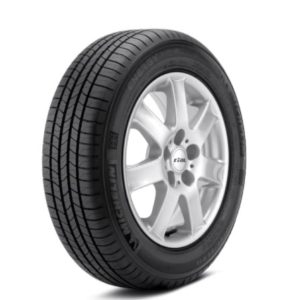
These fuel-efficient All-Season Passenger car tires are designed to optimize your vehicle’s fuel economy without abandoning dry, wet, and wintertime traction. They enhance vehicle performance and environmental impact by reducing fuel consumption and carbon dioxide emissions. The tires provide year-round traction, even in light snow.
The tires are made using Michelin’s Energy Saver Construction from a unique silica-based tread rubber. The advanced material helps to improve engine fuel efficiency by keeping the tire cooler. This rubber is molded into a symmetric design that features independent tread blocks for predictable handling and all-season traction.
The tire’s Circumferential and lateral grooves direct water through the tread design, which helps to resist hydroplaning and enhance wet traction. The tires are constructed using computer-optimized design and precision manufacturing. This, in turn, reduces vibrations and road noise.
The tire’s internal structure uses twin steel belts reinforced by spirally wrapped polyamide on top of a polyester cord casing for maximum strength and durability.
Features
- 6-year tread life warranty
- 1-year uniformity warranty
- 6-year workmanship and materials warranty
- Material; Silica-based tread rubber
- Symmetric design
- Independent tread blocks
- Circumferential and lateral grooves
Pros
- Year-round traction
- Low rolling resistance
- Enhanced wet traction
- Computer-optimized design
- Reduced vibrations and road noise
Cons
- Tread lifespan is limited.
Check it here: https://www.tirerack.com/tires/tires.jsp?tireMake=Michelin&tireModel=Energy%20Saver%20A/S&partnum=665TR8ESAS
BRIDGESTONE ECOPIA EP422 (H- OR V-SPEED RATED)
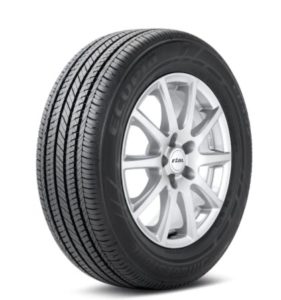
The Bridgestone All-Season tires are perfect for coupes, sedans, minivans, and small crossover vehicles looking to combine year-round traction improved handling and comfort, and fuel efficiency. The tires enhance vehicle fuel economy by reducing tire rolling resistance. Economic fuel usage, in turn, decreases the vehicle’s carbon dioxide (CO2) emissions.
The tires are made using an all-season tread compound using Bridgestone’s unique Nanostructure-Oriented Properties Control Technology. The compound is molded into a symmetric tread design that combines notched shoulders and intermediate ribs with independent center blocks for improved dry traction.
It also features four circumferential grooves designed to help water flow for better hydroplaning control, enhancing wet traction. The tire’s internal structure is supported by twin steel belts reinforced using spirally wrapped nylon in a polyester casing for optimal ride comfort and durability
.
Features
- 5-year tread life warranty
- 5-year workmanship and materials warranty
- Nanostructure-oriented Properties Control Technology
- Dry, wet, and wintertime traction
- Symmetric tread design
- Notched shoulders
- Intermediate ribs
- Independent center blocks
- Four circumferential grooves
- Twin steel belts
Pros
- Reduced tire rolling resistance
- All-season tread
- Higher ride comfort
- Durable
- 90-day Buy and Try Guarantee
Cons
- Not ideal for snowy roads
Check price: https://www.tirerack.com/tires/tires.jsp?tireMake=Bridgestone&tireModel=Ecopia+EP422+(H-+or+V-Speed+Rated)&AID=10398365&PID=8751758&cjevent=d3140ee9017011eb815601990a18050e
Can tires affect fuel efficiency?
Yes. Tires affect fuel efficiency. But the answer is a little more technical than that. The relationship between tires and mpg is all about the tire’s design and how it helps the car reduce rolling resistance.
Rolling resistance
Physics laws dictate that stationery objects remain stagnant unless force is applied.
Simply put, this is the force that resists motion when the wheel hits the surface. This is determined by inertia, road quality, and air drag. Rolling resistance changes as the surface of the road changes and depending on the weather.
Any seasoned driver would know that driving on snow is not the same as driving on a wet or dry road. Similarly, driving on a dirt road is not the same as driving on an asphalt road. The speed of the vehicle also affects the rolling resistance. The gradient of the road also plays a role.
To reduce the rolling resistance, manufacturers have started to make tires with compounds that can increase traction to minimize resistance. The tread designs and sidewalls are also designed to reduce rolling resistance.
How does tire design affect fuel efficiency?
Here are elements of tire design that play a role in fuel efficiency.
• Tread depth and pattern
30-50% of rolling resistance comes from the tire tread design. Research shows that shallower treads tend to be better for fuel-efficiency. Treads grab the asphalt, which requires your car to burn more fuel to create the energy needed to keep the vehicle moving forward. This is why race car drivers use bald tires to reduce fuel consumption and increase car speed.
• Tire size
A car uses less effort to power the start up of a car with small tires than larger tires. However, when in motion, the smaller tire consumes more fuel than the larger tire because of the number of tire rotations per minute. But considering that a smaller tire is fitted in a smaller vehicle, the smaller car’s weight balances out the fuel consumed compared to a larger vehicle.
• Tire pressure
Did you know that deflating your tires by eight psi can reduce rolling resistance by up to20%? According to research, underinflating your tires by 20% can increase fuel efficiency by 10%. Lower tire pressure also leads to tread depreciation that leads to reduced rolling pressure.
• Tire status
As you tire get older, the treads wear down, which in turn reduces the rolling resistance. This is because the shallower tread does not grab the ground as much as a well-defined tire would. This, in turn, reduces the amount of fuel used to power the car.
This, however, does not mean you should drive worn out tires. The lack of traction due to shallow tread can be hazardous when braking, leading to an accident.
How much difference do tires make to fuel economy?
The United States Department of Energy estimates that 5% to 15% of fuel consumption is related to rolling resistance. A 5% improvement in rolling resistance might translate into around 2% less fuel consumed. This means that if you were previously spending $100,000 on energy annually, 2% saving is equivalent to $2000. That is a reasonably massive saving over time.
If this is not convincing, let us consider the fuel economy of different types of tires. All-terrain tires increase fuel consumption by 3% compared to highway tires. Suppose your annual driving distance is 15,000 miles, and your average mileage is 20 mpg, the extra fuel cost comes to $67.50.
Actual calculation = ((15000/20) *3/100) *3=67.5
The saving may seem minute, but why spend more on fuel when you can save it. This is highly beneficial if you need to cut your expenses or reduce fuel consumption for environmental saving reasons.
While the Eco branded tires may claim to be better for your car, you can still attain the same advantages with standard tires. All you have to do is consider the tread pattern, tire size, and tire pressure. Opting for eco tires is not a necessity. But you can still go for them if it will give you peace of mind and if the features are ideal for your vehicle.
Conclusion:
The best car tires for fuel efficiency should be durable while offering fuel efficiency advantages at the same time. It should also have enough traction to function on dry roads, snowy roads, and wet roads. Lastly, it should be able to reduce car vibration and road noise.
